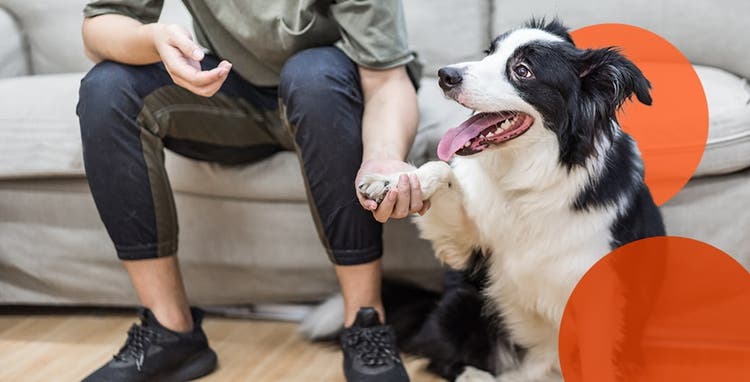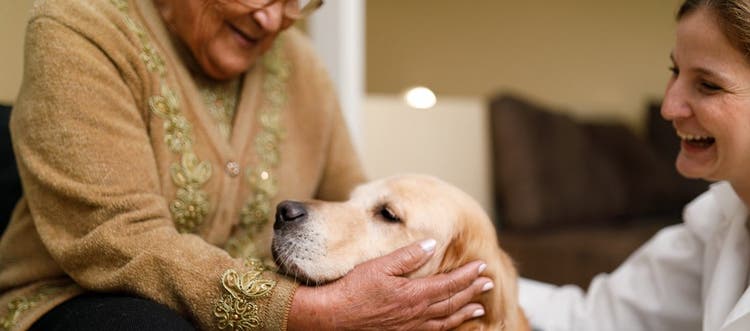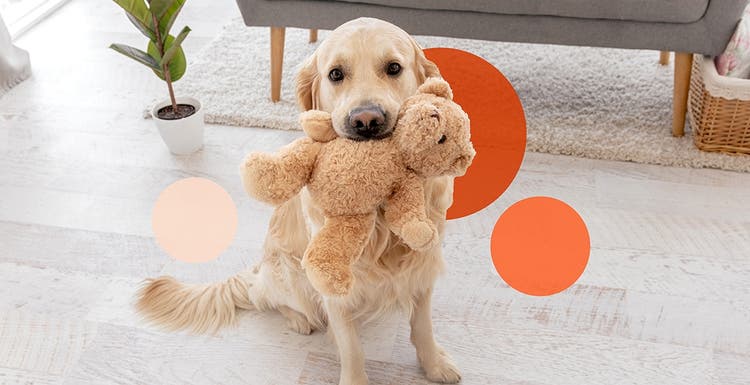A step-by-step guide to teach your dog new tricks.
Training your dog to do tricks can be a fun, enriching experience for both of you. Dogs enjoy training because they get lots of attention, stimulating mental exercise and treats, of course. Training your dog can be a rewarding way to bond with your pup.
With the right techniques and a bit of practice, any dog can learn to do the following five tricks.
Trick 1: Sit
One of the most popular and simple commands, “sit” is a great first trick to teach your dog.
- Hold a treat firmly in your hand and get your dog’s attention with it. Position your hand with the treat above your dog’s head, high enough that they can’t reach it, but not so high that they try to jump for it.
- Give the “sit” command. At the same time, slowly move your hand away from your body, toward your dog’s back and tail. Many dogs will tip their heads back as they follow the treat and will sit instinctively.
- If your dog sits, say, “Yes!” as soon as their back end hits the ground. Give your dog the treat, followed by praise.
If your dog doesn’t sit after the first few attempts with this method, avoid pushing down on their backside or forcing them into the “sit” position. Instead, observe your dog’s normal behavior. When you see your dog getting ready to sit, say “Sit,” followed by “Yes!” or “Good!” and give them a treat. They will slowly begin to associate sitting with your positive reinforcement and verbal cues.
Trick 2: Shake Hands
Though this trick looks impressive, it’s actually simple to teach. Follow these seven steps.
- Start with a treat enclosed in your hand.
- Your dog will smell the treat and try to get to it. Keep your hand closed. Most dogs’ natural instincts will prompt them to paw at something they cannot reach with their mouths.
- The moment your dog reaches up to your hand with their paw, say “Yes!” and give the treat.
- Repeat until your dog quickly offers the paw to your closed hand each time.
- Next, offer a flat and empty palm to your dog. When they put their paw on your hand, offer a treat.
- Increase the time your dog’s paw is in your hand before giving the treat.
- Then add a verbal cue — such as “Shake!” — just before offering your flat palm.
After repeating these steps a few times, your dog will have learned the trick.
Trick 3: Roll Over
Repetition is key in teaching your dog any trick. This especially holds true for the “roll over” trick. The more your dog completes the following steps, the better they will get.
- Start with your dog lying down.
- Offer a treat near your dog’s nose without letting it go. Move your hand to the side, over their shoulder, so that your dog has to lift their head and shift onto their side to retrieve it. Give them the treat.
- Immediately offer another treat — again, without letting it go — and encourage your dog to shift their weight and roll. Put the treat slightly out of reach on the floor so that your dog has to roll all the way over to get it. If your dog achieves this, praise them and give them another treat.
- After several successful rolls, start giving the “roll over” command and slowly phase out the treat.
Keep practicing consistently. It may take a while before your dog smoothly rolls over using just one treat.
Trick 4: Play Dead
Similar to the “roll over” trick, for the “play dead” trick, your dog will roll on their back and stay in position without rolling all the way over. Once your dog has mastered “roll over,” encourage them to “play dead.”
- Start with your dog lying down.
- Offer a treat to one side of your dog’s nose, and then move your hand with the treat to the side of their body to encourage them to roll onto their back.
- When your dog is on their back, say, “play dead” or “dead.” It sometimes helps to accompany this verbal cue with a hand signal, such as a raised palm. Lay one of your hands on your dog’s chest to keep them in position.
- Once your dog lies on their back for a few seconds, say “Yes!” and reward them with a treat.
Trick 5: Take a Bow!
A bow can be the perfect trick to end with after showing off all of your dog’s new tricks. To take a bow, your dog will lean down on their front elbows with their chest touching the ground. Your dog’s rear end will stay up in the air.
- Your dog should be standing to start, with all four paws on the ground. It’s helpful if they can stand on command.
- Hold a treat at the tip of your dog’s nose and slowly move it down toward the ground, holding it close to your dog’s body, enticing them down until their front legs are on the floor with their rear end remaining up.
- Some dogs find this position tricky to begin with. If your dog is having trouble understanding, try placing one arm underneath their stomach to keep their rear end in the air, and use your other hand with the treat to coax them down. Repeat this process until your dog understands the desired movement.
- Keep your dog in the bow position, and then use the treat to invite them up to a standing position again. Say “Yes!” or use a clicker, and give the treat.
- Keep repeating and practicing. Eventually add a cue word or phrase — such as “Take a bow!” — before you start the trick. Before you know it, your dog will be able to bow on command.
Your dog will be wowing friends and family with their new tricks in no time.

K9 Advantix® II
A convenient, monthly topical application that kills and repels fleas and ticks through contact, so they don't have to bite your dog to die. Do not use on cats.

Seresto® Flea & Tick Collar for Dogs
An easy-to-use, odorless, non-greasy collar that kills and repels fleas and ticks for 8 continuous months.

Advantage® II for Dogs
A convenient, monthly topical application that kills fleas through contact so they don't have to bite your dog to die.







